Traffic light food labels strengthen self-control

Prof. Dr. Bernd Weber and Laura Enax of the Center for Economics and Neuroscience (CENs) at the University of Bonn evaluate brain scanner data. (c) Photo: Uni Bonn
Red, yellow, green: The traffic signal labels on packages are supposed to be an easy-to-understand indication of the overall “healthiness” of a food product. For example, “red” symbolizes a high percentage of fat, sugar or salt, “green” a lower percentage. Just as on an actual traffic light, yellow falls in the middle. “
This is the first study that analyzes the effect that traffic light signals have on the evaluation processes in the consumer's brain when making a purchase decision”, says Prof. Dr. Bernd Weber of the Center for Economics and Neuroscience (CENs) at the University of Bonn. Do the “traffic lights” help consumers choose a healthier diet when grocery shopping? Scientists from the CENs have addressed this question in a recent study.
100 products – from chocolate to ready-to-serve meals
A total of 35 adult study participants, 19 of which were women, participated in the study at the Life & Brain Center in Bonn. 100 products and their nutritional information were shown to the participants lying in the brain scanner – from chocolate to yogurt to ready-to-serve meals. The participants were shown this information either in the form of currently used nutrition labels with grams and percentages per portion, or in the form of traffic light labels. Then participants had to indicate how much they were willing to pay for a particular product.
The participants were willing to pay significantly more money for the same product when the traffic light label was “green” compared to an information-based label. However, if the label was “red”, the willingness to pay decreased more compared to the conventional information. “You can conclude that the traffic light label acts as a reinforcer: The health relevance of the ingredients is weighed more heavily into purchasing decisions compared to simple nutrition information”, says first author Laura Enax of CENs.
Two brain regions affect the reward system
While study participants were thinking about what price they wanted to pay for a particular product, the scientists recorded the activity of various brain regions using functional magnetic resonance imaging. A red traffic light label activated a structure in the left inferior frontal gyrus, which has been repeatedly shown to be important for self-control. Activity in this region influenced the ventromedial prefrontal cortex, a region that “calculates” the subjective value of a product via the reward system, leading to decreased willingness to pay for unhealthy products.
“The traffic light label appears to enable the study participants to better resist unhealthy foods compared to a label containing the traditional information on grams and percentages of the particular ingredients. A traffic light label probably implicitly increases the weight consumers place on healthiness in their decision”, says Prof. Weber, summarizing the result. The scientists at the University of Bonn now want to examine more closely how different types of food labels can be used to support consumers in their decision-making.
Publication: Nutrition labels influence value computation of food products in the ventromedial prefrontal cortex, “Obesity”, 10.1002/oby.21027
Media Contact:
Prof. Dr. Bernd Weber
Center for Economics and Neuroscience
Life & Brain Center
at the University of Bonn
Tel. +49-(0)228-6885262
E-mail: bernd.weber@ukb.uni-bonn.de
Media Contact
More Information:
http://www.uni-bonn.de/All latest news from the category: Studies and Analyses
innovations-report maintains a wealth of in-depth studies and analyses from a variety of subject areas including business and finance, medicine and pharmacology, ecology and the environment, energy, communications and media, transportation, work, family and leisure.
Newest articles

Parallel Paths: Understanding Malaria Resistance in Chimpanzees and Humans
The closest relatives of humans adapt genetically to habitats and infections Survival of the Fittest: Genetic Adaptations Uncovered in Chimpanzees Görlitz, 10.01.2025. Chimpanzees have genetic adaptations that help them survive…

You are What You Eat—Stanford Study Links Fiber to Anti-Cancer Gene Modulation
The Fiber Gap: A Growing Concern in American Diets Fiber is well known to be an important part of a healthy diet, yet less than 10% of Americans eat the minimum recommended…

Trust Your Gut—RNA-Protein Discovery for Better Immunity
HIRI researchers uncover control mechanisms of polysaccharide utilization in Bacteroides thetaiotaomicron. Researchers at the Helmholtz Institute for RNA-based Infection Research (HIRI) and the Julius-Maximilians-Universität (JMU) in Würzburg have identified a…



